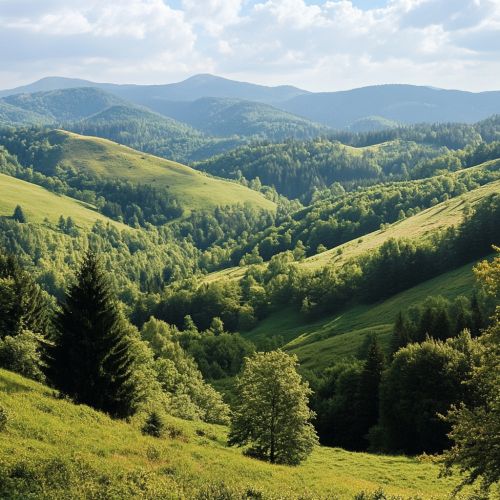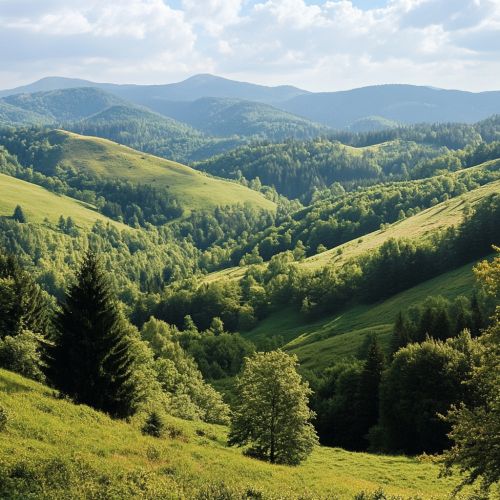Eastern Europe: Difference between revisions
(Created page with "== Geography and Topography == Eastern Europe is a region that encompasses the eastern part of the European continent. It is characterized by diverse geographical features, including vast plains, mountain ranges, and extensive river systems. The region stretches from the Ural Mountains in the east to the borders of Germany and Austria in the west, and from the Arctic Ocean in the north to the Black Sea and the Caucasus Mountains in the south. <div class='only_on_deskto...") |
No edit summary |
||
| Line 3: | Line 3: | ||
Eastern Europe is a region that encompasses the eastern part of the European continent. It is characterized by diverse geographical features, including vast plains, mountain ranges, and extensive river systems. The region stretches from the Ural Mountains in the east to the borders of Germany and Austria in the west, and from the Arctic Ocean in the north to the Black Sea and the Caucasus Mountains in the south. | Eastern Europe is a region that encompasses the eastern part of the European continent. It is characterized by diverse geographical features, including vast plains, mountain ranges, and extensive river systems. The region stretches from the Ural Mountains in the east to the borders of Germany and Austria in the west, and from the Arctic Ocean in the north to the Black Sea and the Caucasus Mountains in the south. | ||
[[Image:Detail-97705.jpg|thumb|center|Carpathian Mountains landscape with lush green forests and rolling hills.|class=only_on_mobile]] | |||
[[Image:Detail-97706.jpg|thumb|center|Carpathian Mountains landscape with lush green forests and rolling hills.|class=only_on_desktop]] | |||
The most prominent mountain ranges in Eastern Europe include the Carpathian Mountains, which extend through countries such as Poland, Slovakia, Ukraine, and Romania, and the Balkan Mountains in Bulgaria. The region also features the vast East European Plain, which is one of the largest continuous expanses of flatland in the world. Major rivers such as the Volga, Dnieper, and Danube play crucial roles in the geography and economy of Eastern Europe. | The most prominent mountain ranges in Eastern Europe include the Carpathian Mountains, which extend through countries such as Poland, Slovakia, Ukraine, and Romania, and the Balkan Mountains in Bulgaria. The region also features the vast East European Plain, which is one of the largest continuous expanses of flatland in the world. Major rivers such as the Volga, Dnieper, and Danube play crucial roles in the geography and economy of Eastern Europe. | ||
Latest revision as of 12:36, 19 August 2024
Geography and Topography
Eastern Europe is a region that encompasses the eastern part of the European continent. It is characterized by diverse geographical features, including vast plains, mountain ranges, and extensive river systems. The region stretches from the Ural Mountains in the east to the borders of Germany and Austria in the west, and from the Arctic Ocean in the north to the Black Sea and the Caucasus Mountains in the south.


The most prominent mountain ranges in Eastern Europe include the Carpathian Mountains, which extend through countries such as Poland, Slovakia, Ukraine, and Romania, and the Balkan Mountains in Bulgaria. The region also features the vast East European Plain, which is one of the largest continuous expanses of flatland in the world. Major rivers such as the Volga, Dnieper, and Danube play crucial roles in the geography and economy of Eastern Europe.
Historical Context
Eastern Europe has a rich and complex history that has been shaped by various empires, kingdoms, and states. The region has seen the rise and fall of numerous powerful entities, including the Byzantine Empire, the Ottoman Empire, and the Austro-Hungarian Empire. The influence of these empires is still evident in the cultural and architectural heritage of the region.
During the medieval period, Eastern Europe was a battleground for various powers, including the Mongol invasions and the Crusades. The region was also a significant part of the Eastern Orthodox and Byzantine cultural spheres, which left a lasting impact on its religious and cultural traditions.
The 20th century brought significant changes to Eastern Europe, particularly with the aftermath of World War I and World War II. The region experienced the rise of communist regimes under the influence of the Soviet Union, leading to the establishment of the Eastern Bloc. The Cold War era saw Eastern Europe as a focal point of geopolitical tensions between the Western powers and the Soviet Union.
Political Landscape
The political landscape of Eastern Europe has been shaped by its tumultuous history and the legacy of the Cold War. After the collapse of the Soviet Union in 1991, many Eastern European countries transitioned from communist regimes to democratic governments and market economies. This period of transition was marked by significant political and economic reforms, as well as challenges such as corruption, political instability, and economic hardship.
Today, Eastern Europe is a diverse region with a mix of political systems, ranging from established democracies to more authoritarian regimes. Countries such as Poland, Hungary, and the Czech Republic have become members of the European Union and NATO, while others, like Belarus and Russia, maintain closer ties with the Commonwealth of Independent States (CIS) and other post-Soviet structures.
Economy
The economy of Eastern Europe is diverse and varies significantly from one country to another. The region has undergone substantial economic transformation since the end of the Cold War, with many countries transitioning from centrally planned economies to market-oriented systems. This transition has been accompanied by privatization, foreign investment, and integration into global markets.
Eastern Europe is rich in natural resources, including oil, natural gas, coal, and minerals. Countries such as Russia and Ukraine are major energy producers and exporters, while others, like Poland and Romania, have significant industrial and manufacturing sectors. Agriculture also plays a crucial role in the economies of many Eastern European countries, with fertile plains and favorable climates supporting the production of grains, vegetables, and livestock.
Despite these economic strengths, the region faces challenges such as income inequality, unemployment, and underdeveloped infrastructure. Efforts to address these issues have included economic reforms, investment in infrastructure projects, and initiatives to attract foreign investment.
Culture and Society
Eastern Europe is a culturally rich and diverse region, with a wide range of languages, traditions, and customs. The region's cultural heritage has been shaped by its complex history and the influence of various empires, religions, and ethnic groups.
The predominant religions in Eastern Europe are Eastern Orthodoxy, Roman Catholicism, and Islam, with significant populations of Jews and Protestants as well. Religious traditions and holidays play an important role in the cultural life of the region, with celebrations such as Easter, Christmas, and Ramadan being widely observed.
Eastern Europe is also known for its rich artistic and literary traditions. The region has produced numerous renowned writers, composers, and artists, including figures such as Fyodor Dostoevsky, Leo Tolstoy, and Frédéric Chopin. Folk music, dance, and crafts are also integral parts of the cultural heritage of Eastern Europe, with each country having its own unique styles and traditions.
Demographics
The demographics of Eastern Europe are characterized by a diverse mix of ethnic groups, languages, and cultures. The region is home to numerous ethnic minorities, including Russians, Ukrainians, Poles, Hungarians, Romanians, and many others. This diversity is reflected in the linguistic landscape of Eastern Europe, with a wide range of languages spoken, including Russian, Polish, Ukrainian, Romanian, Hungarian, and others.
Population trends in Eastern Europe have been influenced by factors such as migration, urbanization, and demographic changes. The region has experienced significant emigration, particularly during the post-communist transition period, as people sought better economic opportunities and political stability in Western Europe and other parts of the world. Urbanization has also been a major trend, with many people moving from rural areas to cities in search of employment and improved living conditions.
Education and Science
Education and science have played important roles in the development of Eastern Europe. The region has a long tradition of academic excellence, with many prestigious universities and research institutions. Countries such as Russia, Poland, and Hungary have made significant contributions to fields such as mathematics, physics, chemistry, and engineering.
The education systems in Eastern Europe have undergone significant reforms since the end of the Cold War, with efforts to modernize curricula, improve educational infrastructure, and increase access to higher education. These reforms have aimed to align the education systems with international standards and to better prepare students for the demands of the global economy.
Scientific research and innovation are also important priorities for many Eastern European countries. The region has a strong tradition of scientific inquiry, with notable achievements in areas such as space exploration, nuclear physics, and information technology. Collaborative research projects and partnerships with international institutions have further enhanced the scientific capabilities of Eastern Europe.
